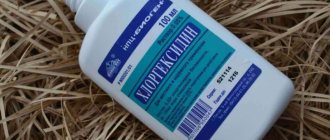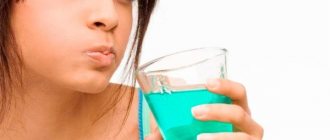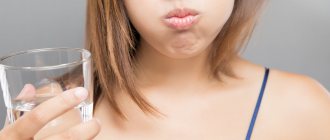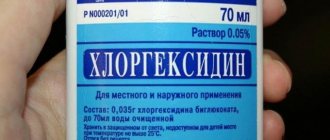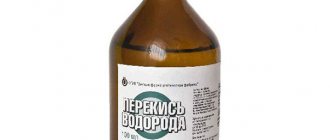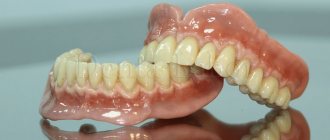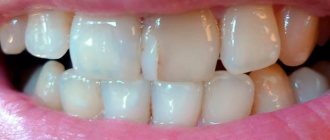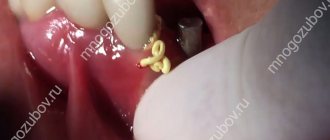08/19/201809/20/2020 Olga Migunova 2 comments
Modern methods of combating various diseases lead to the search for effective and affordable antibacterial agents. Chlorhexidine has established itself as a very active medicine, capable of solving many problems associated with the spread of bacteria and viruses in a short time with a minimum number of contraindications and consequences. The drug has received the greatest scope of application in the treatment of inflammatory processes in the oral cavity, as well as in the treatment of sexually transmitted diseases. Today we will talk about how to gargle with Chlorhexidine.
- 1 Description of the drug
- 2 For what throat diseases can Chlorhexidine be used?
- 3 Do I need to dilute Chlorhexidine?
- 4 General rules for gargling
- 5 Rinse during pregnancy
- 6 Rinse for children
- 7 Features of using the drug for angina
- 8 Contraindications for use
- 9 Possible complications
- 10 Conclusion
Composition and characteristics of Chlorhexidine
This drug is produced by dozens of enterprises, including Russian ones. Solutions are available in the following concentrations:
The composition of Chlorhexidine contains only two components:
- chlorhexidine bigluconate;
- purified water.
The release form is plastic or glass vials of various sizes. Most often you can buy the drug in pharmacies in volumes of 100 or 500 milliliters. Bottles with a volume of 2 liters or more are available for medical institutions.
Studies have been carried out, as a result of which it turned out that as a result of using this product, the death of bacteria occurs in no more than a minute, and fungi - in 10 minutes.
Description of the drug
Chlorhexidine is an antiseptic drug that is active against gram-positive and gram-negative bacteria, some protozoa, as well as the causative agent of the herpes virus. The product is used to disinfect surfaces during surgical interventions, treat surgeons' hands and skin surfaces. After treatment, it retains the bactericidal effect for some time. There is a decrease in the bactericidal effect in the presence of organic liquids (blood, pus, lymph).
Externally, Chlorhexidine is a clear liquid similar to water. In the finished solution, the active ingredient is chlorhexidine bigluconate. The concentration of the active substance in the solution varies - 0.05% and 20%, and, accordingly, the release volume is 100 and 500 milliliters.
If you do not have the time or opportunity to read the entire article, watch the video on this topic:
Chlorhexidine has high antibacterial activity. Its field of influence includes E. coli, gonococci, Klebsiella, staphylococcus and streptococcus, the causative agent of syphilis and tuberculosis, chlamydia, ureaplasma, viral hepatitis and many others. Treatment of the skin with a solution of Chlorhexidine does not lead to the absorption of its active component into the blood.
Depending on the concentration of the active component, the scope of application of the solutions is different. A 20% solution is used for the following purposes:
- the surgeon's hands and the surgical field are treated before manipulation;
- in food production, the hands of workers are disinfected;
- antibacterial treatment of the skin of the hands of medical workers of any profile;
- in treatment rooms, treatment of the injection site;
- processing of small medical instruments.
A solution of higher concentration is used to prepare a solution of lower concentration. A weak solution, in turn, is used for preventive purposes to avoid re-infection during surgery, as well as in the treatment of pathological skin conditions due to fungal or bacterial diseases, wound suppuration, and infectious diseases of the mucous membranes.
Chlorhexidine is highly effective in the treatment and prevention of many infectious diseases that are predominantly sexually transmitted.
Chlorhexidine solution has become widespread in the treatment of many diseases of the oral cavity, including dental diseases.
Treatment of throat with Chlorhexidine
This drug is capable of:
- Inhibit the activity of pathogenic microorganisms. It affects microbes, bacteria, fungus, and some parasites.
- This product does not have a destructive effect on beneficial microflora.
- If there has been damage to soft tissues, the drug enhances regeneration processes, promoting the healing of damage.
- Helps remove plaque from teeth.
If the patient has a purulent sore throat, antibiotics will be needed for treatment. Chlorhexidine enhances the effect of macrolytics and cephalosporins.
After the end of rinsing, the effect of the drug continues for another 18 hours. As a result of the procedures performed, a protective film is formed.
It is used in the following cases:
- When the tonsils were inflamed.
- If you have tonsillitis.
- In cases where there was an acute respiratory viral infection (ARVI), with influenza, in the presence of acute respiratory infections.
- For patients suffering from tracheitis, pharyngitis, laryngitis. The drug is used for both chronic and acute forms of the disease.
- With the help of such rinses it is possible to treat the consequences arising from nicotine use.
Features of using the drug for angina
Sore throat is an inflammation of the pharyngeal tonsil with the appearance of purulent formations on it.
The disease is acute, characterized by high body temperature with severe intoxication. When swallowing, you feel a strong cutting pain in the throat, hyperemia of the tonsils, and after some time plaque and purulent formations appear. For local treatment, in combination with broad-spectrum antibiotics, throat irrigation with Chlorhexidine solution is used. It has a bactericidal, antimicrobial, antiseptic and disinfectant effect. Relieving swelling and softening a sore throat, it helps remove plaque, pus and prevents the proliferation of pathogenic microflora.
It is convenient to use chlorhexidine for a sore throat in vials with a special spray dispenser. It allows you to cover the area of inflammation as widely as possible, which contributes to a speedy recovery.
How is it recommended to dilute the drug?
If you purchase a ready-made solution, this can serve as a guarantee that the correct concentration of Chlorhexidine is available. It has a concentration of 0.05%. If you breed yourself, you must not exceed this norm. Otherwise, it will lead to painful consequences.
If the patient is over 12 years old, the standard concentration of the drug is suitable for him. No additional dilution is required during use. If you need to treat a child over six years old, the standard solution must be diluted in half with warmed clean water.
For children aged 5 years or less, the drug must be diluted with water in the ratio: two parts water to one part Chlorhexidine solution of standard concentration. At this age, spraying rather than rinsing is used to treat a child. For one procedure, you can take no more than a teaspoon of the solution prepared in the specified manner.
When using this drug, you need to take into account that if it is in an open state, after about 40 minutes it will lose its beneficial properties.
Treatment of wounds in children
Children of different ages very often receive all kinds of injuries and wounds. Kids are very actively exploring a new world for them, and in the process of getting to know it, they do not do without abrasions.
Children learn to rollerblade and bicycle, play outdoor games, climb trees, swing on swings, play various sports, communicate with animals, and quite often they get various injuries that require antibacterial treatment in order to prevent the penetration of harmful microorganisms and spread infections.
Since Chlorhexidine does not have a toxic effect on the body, does not cause adverse reactions or allergic manifestations, it can also be used to treat wounds, abrasions and other skin lesions even in very young children.
How to gargle correctly
The composition of a single dose is a tablespoon of Chlorhexidine solution. It contains from 10 to 15 grams of the drug. Before the procedure, you need to thoroughly rinse your mouth with warm water.
If you have to rinse, it is not recommended to brush your teeth before doing this. The reason is that certain components of toothpaste can react with Chlorhexidine.
You need to do the following:
- Rinse your mouth with water first.
- For the procedure you need to take a tablespoon of the product. Rinse is required for 30 seconds. Then the solution must be spat out.
- Then you need to wait a little and do another rinse.
- It is not recommended to eat in the next hour or hour and a half.
If the sore throat is severe, the procedure can be performed more often than usual. For example, it can be done every three hours.
Chlorhexidine stains teeth
Chlorhexidine, or in other words chlorhexidine bigluconate, is a substance known to many. Today it is in the home medicine cabinet of almost every family. In most cases, it is used to treat damaged skin areas and disinfect various household items from infections.
Not many people know that Chlorhexidine, according to the instructions for use for mouth rinsing, is a universal liquid for treating the human oral cavity and pharynx for many relevant pathologies.
Chlorhexidine for mouth treatment
An antiseptic substance with a wide spectrum of effects, it is active against most bacteria pathogenic to humans. It has a detrimental effect on both gram-positive and gram-negative microorganisms, viruses and fungal infections.
The substance is available in the form of a solution (0.05%, 0.1%, 0.2%, 0.5%, 1%, 5% and 20%). Therefore, you should carefully check the bottle label before you start rinsing your mouth with chlorhexidine. Some concentrations of the substance are not used by dentists and otolaryngologists in their practice. Thus, a solution containing more than 0.1% is not applicable for treating human skin and mucous membranes.
Having chosen Chlorhexidine as an antiseptic, study the instructions for use for mouth rinsing. The substance is effective for most inflammations in the human oral cavity:
- for gingivitis, stomatitis, gum inflammation;
- with inflammation at the site of an extracted tooth;
- with inflammation of the tissue over erupting teeth - figure eights;
- when disinfecting prosthetic elements;
- for infections of the pharynx and larynx.
A prerequisite for practicing chlorhexidine digluconate mouthwash is the infectious nature of the disease. If the inflammation is caused, for example, by an allergy, then using this solution in accordance with the instructions for use will be pointless.
Chlorhexidine: rinse during pregnancy
Since the active substance of the drug does not penetrate into the bloodstream during oral irrigation and practically does not enter the body (if it is not deliberately swallowed), Chlorhexidine for rinsing the mouth during pregnancy is allowed in the instructions for use.
In these special cases, a natural question arises: is it necessary to dilute Chlorhexidine for mouth rinse? The answer is no, it is not necessary. The same optimal concentration is used - 0.05%. More information about rinsing your mouth with this drug during pregnancy can be found in this article.
How to use for rinsing
Chlorhexidine solution for mouth rinse is allowed to be used in all categories of patients. The only condition in accordance with the instructions for use of the drug will be mandatory local use. That is, it is forbidden to swallow it. Therefore, in young children it is recommended to use it in the form of a spray.
If you do swallow the substance, consult a doctor. It is necessary to perform gastric lavage with a large amount of water at human body temperature and absorption therapy. Additional symptomatic treatment may be required.
In the practice of dentists and ENT doctors, chlorhexidine bigluconate is widely used; instructions for using it for mouth rinsing are as follows:
- It is necessary to rinse your throat with water at body temperature before doing this.
- Take about 15-20 ml of solution (a tablespoon) and rinse.
- The procedure should last at least half a minute.
- Afterwards, the antiseptic is spat out; there is no need to wash it off further!
When Chlorhexidine is prescribed, the instructions for mouth rinse are simple. All hygiene procedures (teeth brushing) must be carried out before sanitation. Remaining paste should be rinsed well, as it can reduce the therapeutic properties of the solution.
Do I need to dilute the mouthwash?
When you first get acquainted with the liquid, reading the instructions, the question may arise: is it necessary to dilute Chlorhexidine when rinsing your mouth?
Typically, doctors prescribe a solution with a 0.05% antiseptic to patients. It does not require additional preparation; it is produced completely in finished form.
Liquids are also produced with a higher concentration of the active substance. But they are not applicable for treatment in direct contact with human skin and mucous membranes. Such antiseptics have found their active use in the disinfection of personal hygiene items and household appliances indoors.
If you do not have the opportunity to purchase a ready-made 0.05% solution directly, then you should know how to dilute Chlorhexidine for mouth rinse. There are a number of recommendations for this.
How to dilute mouthwash
If the question arises - how to dilute Chlorhexidine for mouth rinsing - the instructions for use advise us to take into account its initial concentration. The proportion calculates the volume of water to achieve 0.05% of the active composition in the liquid. The dilution algorithm is shown in the table:
The maximum permissible concentration for treating tissue in humans is 0.1%. For children, it is possible to dilute a standard solution of 0.05% to less concentrated liquids.
Use for mouth rinse
How to use Chlorhexidine as a mouth rinse in dentistry?
Dentists recommend sanitation with this antiseptic 2 times every day, as prescribed in the instructions for use.
After tooth extraction
Be sure to disinfect:
- with complicated tooth extraction;
- with an active inflammatory process (acute infection);
- when foci of chronic infection are detected (caries, ulcers, tartar).
Chlorhexidine for mouth rinse after tooth extraction is prescribed for a small number of procedures according to the instructions for use. They should be started no earlier than 120 minutes after visiting the dentist.
It is necessary to lightly rinse the mouth so as not to wash out the blood clot, which protects the hole remaining from the tooth from infection getting inside.
In case of inflammation of the site of the extracted tooth
This situation is possible when the site of the extracted tooth becomes infected and the infectious inflammatory process begins. In such cases, Chlorhexidine mouthwash is indicated as an antiseptic. The main treatment should be prescribed by a doctor.
At the onset of gum inflammation caused by the growth of the “eight”
The so-called “wisdom” teeth (figure eights) are usually difficult to erupt. Cavities appear from the tissue above them. Food is easily deposited in these pockets, and inflammation occurs if they are not cleaned sufficiently. It intensifies when the tongue constantly touches this place, causing unpleasant sensations.
Read also: Healing gel for gums
In these situations, Chlorhexidine in dentistry for mouth rinsing is applicable in consultation with the attending physician.
For stomatitis
For this disease, as indicated by the instructions for use, this antiseptic is used as antibacterial, antiviral or antifungal protection.
Treatment with the drug is prescribed up to three times a day. If additional gargling is required between procedures, use other solutions (chamomile, sage, soda and salt, chlorophyllipt and others).
Children use Chlorhexidine in the form of a spray. It is necessary to ensure that small patients do not swallow liquid. A child under three years of age is prohibited from directly applying the spray to the tonsils and back of the throat.
Advantages and disadvantages of Chlorhexidine
Chlorhexidine has undeniable advantages for use in dentistry and otorhinolaryngology:
- low retail price;
- good antibacterial effect;
- There is a release form of the substance that is ready for immediate use.
But there are a number of restrictions on the use of antiseptics:
- Chlorhexidine should not be used to treat mucous membranes for more than 10 days in a row.
- If there is plaque or tartar in the patient’s mouth after treatment with the drug, they may darken. This effect is completely reversible some time after stopping rinsing. But it can serve as a marker for the need to visit the dentist and undergo hygienic teeth cleaning.
- It is often impossible for children to practically treat the throat and mouth with the solution because of its bitter taste.
- There is a danger of swallowing the substance. This is absolutely contraindicated. This fact further complicates its use in pediatric patients.
- Side effects of Chlorhexidine, according to the instructions for use, include changes in a person’s sense of taste, dryness and rapid growth of tartar.
- Individual intolerance to the components of the drug and the development of dermatitis are possible. In such cases, therapy should be discontinued immediately and consult a doctor for advice.
Conclusion
When treating dental diseases or throat infections, do not forget about such a powerful antiseptic agent as chlorhexidine digluconate.
Having a wide range of effects on microorganisms of various origins, Chlorhexidine reliably protects the affected surfaces from further inflammation.
Always use the correct concentration of the substance and follow the correct rinsing regimen. With correct and competent use, the symptoms of the disease can be eliminated in a short time.
The solution is approved for use in all groups of patients. It is prescribed with caution only to young children due to the danger of swallowing the substance. There are a number of side effects when treating the skin and mucous membranes with Chlorhexidine.
Is it possible to use chlorhexidine (or another antiseptic) instead of mouthwash?
So we use hCG as a rinse for no more than 10 days, and only on the recommendation of your doctor. The same applies to pastes and rinses containing hCG. You don't need to use them all the time.
It is impossible to constantly use hCG as a rinse aid, because... this solution is antiseptic - it will affect not only pathogens, but also the natural flora of the oral cavity, and as a result of this effect the natural balance of microorganisms will be disrupted; Roughly speaking, “useful microbes” will die in the same way, and their place will be taken by other species, because
in the mouth, as elsewhere, “a holy place is never empty.” Resistance will also be developed - the ability of microorganisms to resist a particular drug, i.e. After some time, hCG will cease to have an effect on pathogenic organisms - it will become useless if there are any problems in the mouth.
Finally, chlorhexidine darkens teeth, and this problem will have to be solved in the doctor’s chair.
So we use hCG as a rinse for no more than 10 days, and only on the recommendation of your doctor. The same applies to pastes and rinses containing hCG. You don't need to use them all the time.
My answer, of course, will not compete with the answers of dentists, but I would just like to warn you. In my case, regular use of chlorhexidine as a mouth rinse led to yellowing (and what a yellowing!) of my teeth. Getting rid of the unpleasant color took a long time and was painful, so be careful.
My answer, of course, will not compete with the answers of dentists, but I would just like to warn you. In my case, regular use of chlorhexidine as a mouth rinse led to yellowing (and what a yellowing!) of my teeth. Getting rid of the unpleasant color took a long time and was painful, so be careful.
","with_cut":false,"clearText":"My answer, of course, will not compete with the answers of dentists, but I would just like to warn you. In my case, regular use of chlorhexidine for mouth rinsing led to yellowing (and what a yellowing!) of my teeth. It took a long time to get rid of the unpleasant color, so be careful.”, “i”:1,”comments”:[]>,
Source: https://profimedspb.ru/lechenie/preparaty/hlorgeksidin-okrashivaet-zuby.html
How is the remedy used to treat children and pregnant women?
In order to use Chlorhexidine in treating a child, he must be over five years old. At the same time, it is necessary that he understands how to rinse and does not swallow the solution inside.
The use of the drug in question is possible for young children only when it is done in the form of irrigation:
- To carry out the procedure, you need to tilt the child’s face over the sink or over the bathtub.
- It is necessary to prepare a syringe without a needle or a syringe filled with Chlorhexidine solution of the correct concentration.
- It is necessary to tilt the child’s face over the sink and spray in the mouth using a prepared device. In this case, it is important that the solution flows into the washbasin, and the child does not have the opportunity to swallow it.
The time spent should not be longer than 30 seconds.
The effect of this drug during pregnancy has not been studied. However, under the supervision of a doctor, the use of Chlorhexidine in this case is permitted. However, it makes sense to rinse with a solution of this drug only as a last resort, provided that the use of other treatments has not been successful.
When used, it is allowed to use a solution of standard concentration, which is 0.05%. However, it is recommended to reduce the dose used by half. The procedure is recommended to be carried out as follows:
- You must first clean your mouth by rinsing it with clean water.
- You need to take one teaspoon of the composition. In this case, the liquid must be heated.
- After the rinsing procedure is completed, it is not recommended to consume food or drinks for an hour and a half.
Rinse during pregnancy
During pregnancy, the use of chlorhexidine bigluconate is not recommended, as is the use of other medications. In cases of emergency and when other means do not help cope with the disease, the use of Chlorhexidine is permissible at a dosage of 0.05% and does not require dilution. The solution is used according to the general scheme recommended for treatment by a specialist.
The use of Chlorhexidine during pregnancy is the first remedy to combat the symptoms of vaginal candidiasis (thrush), as well as to combat the pathogens of syphilis and ureaplasmosis.
During the treatment process, the pregnant woman’s condition is significantly alleviated, and the absence of a negative effect on the development of the fetus has been proven. In addition, during pregnancy, women may be prescribed Chlorhexidine solution in the following cases:
- various sexually transmitted infections (trichomoniasis, herpes, mycoplasma, chlamydia, syphilis);
- inflammatory processes in the vagina of various etiologies;
- treatment of the birth canal before and after labor;
- treatment of sutures after operations;
- infectious diseases of the nasopharynx;
- washing of festering wounds and dermatitis of various etiologies.
The drug can only be used topically. During pregnancy, only irrigation or applications with a solution are used. For women with genital infections, it is convenient to use the drug in the form of suppositories, because the use of douching is unacceptable.
If the concentration of the drug is chosen incorrectly, the consequences
If this drug has too high a concentration, it can lead to the following consequences:
- As a result, the oral mucosa may become dry.
- Chlorhexidine can affect the color of teeth. If you rinse with a concentrated solution, this may cause them to darken.
- Possible effect on taste.
- Sometimes using the drug in such a concentration leads to insomnia.
In order to avoid such consequences, it is necessary to adhere to the appropriate standards when diluting the drug or purchase a ready-made rinse.
What solution to use for rinsing the mouth after implantation
It is recommended to use an aqueous 0.05% solution. It is effective even with large blood clots after extraction and promotes rapid wound healing. Rinses are prescribed in courses as prescribed by the dentist. You cannot use the drug for longer than the recommended period due to the risk of severe irritation of the mucous membrane.
Smokers and people with diabetes can use alcohol-based Chlorhexidine rinses. This composition ensures high safety and stabilization of the drug. Local treatment with an alcohol-containing drug significantly reduces the formation of plaque in the oral cavity, especially after implantation.
What to do if the medicine is swallowed
Although an adult can accidentally swallow a rinse solution, this problem most often occurs in children. If this happens, you need to do this:
- You need to drink at least two glasses of clean water.
- Next you need to induce vomiting.
- Then you need to drink activated carbon tablets. Their dose is calculated based on a person’s weight: one tablet is required for every 10 kg.
These recommendations apply to both children and adults if they accidentally ingest this composition.
Although it is necessary to take appropriate measures when swallowing a medicine, it must be remembered that real harm occurs for an adult if the dose of the swallowed drug exceeds 300 milliliters, if we talk about standard pharmacy concentrations.
The medicine is removed from the human body through feces and urine. Usually the period of complete elimination does not exceed 12 hours.
Chlorhexidine for stomatitis - proven effectiveness!
The main causes of stomatitis are dangerous bacteria and reduced immunity. In addition, it can be a consequence of mucosal injury, general intoxication, and even leukemia.
To treat stomatitis, doctors often prescribe chlorhexidine. How effective is it? We will consider the properties of this drug, indications and contraindications.
We will also find out how effective it is for stomatitis and how to use it correctly.
Properties of the drug
The first symptom of stomatitis is ulcers on the oral mucosa. They are painful and cause severe discomfort. Children often suffer from them. Kids refuse to eat, and sometimes even to communicate. A number of medications are used to combat stomatitis. Among them is chlorhexidine.
Among other drugs of similar action, chlorophyllipt should be noted. Chlorophyllipt for stomatitis is effective and safe. It is used for rinses and applications. An alcohol solution is used. Among folk remedies, baking soda is recommended for stomatitis.
Chlorhexidine is used for rinses and applications.
It can relieve inflammation, fight infection and promote healing of ulcers. You should consult your dentist regarding the use of any of these remedies. It is important to determine why stomatitis developed and prescribe treatment based on this.
Doctors prescribe chlorhexidine for stomatitis very often. Chlorhexidine (chlorhexidine bigluconate) is an antiseptic drug. It has the following properties:
- able to suppress microbial activity;
- fights fungus;
- effective against viruses.
The product suppresses the activity of three groups of pests at once, which cause many diseases.
The product is available in the form of a solution (alcoholic or aqueous), cream, gel, patch. To combat stomatitis, the drug is most often used in liquid form. This is due to the fact that it is used for regular rinsing. A gel may also be prescribed for application.
An effective analogue of Chlorhexidine.
Chlorhexidine is very often prescribed specifically for stomatitis. The powerful effect of the drug is due to the fact that it creates a protective film on the affected surface. It becomes a reliable protection for ulcers and inflammations from ubiquitous bacteria. Using the drug will significantly speed up healing. This has been proven by practicing dentists.
Can chlorhexidine be used to treat children?
As practice has shown, this drug is practically harmless. It is used in pediatrics. But when treating children, you should remember the following precautions:
- Do not allow your child to swallow the solution. If this does happen, you need to neutralize it as described in the instructions.
- Do not use the product for more than 12 days. Long-term use can lead to oral dysbiosis. This is highly undesirable and may require long-term treatment.
Important : There is a virus against which chlorhexidine is absolutely powerless. It's herpes. If it was he who provoked the development of stomatitis, then there is simply no point in using chlorhexidine to treat it. For herpetic stomatitis, other drugs are prescribed.
How effective is it?
Even after rinsing, it is still active in the fight against infection for a certain time.
To combat stomatitis, doctors prescribe chlorhexidine as a bactericidal and bacteriostatic drug. It is important that the doctor chooses the treatment regimen. He will prescribe exactly the form of the drug that will be most effective in a particular case of the disease. It should be remembered that there are different types of stomatitis. They are treated with different drugs. The concentration of the drug is also important.
To suppress the growth of bacteria, it is best to use a solution of chlorhexidine (0.01%). In some cases, a stronger concentration of the drug is used. It is used for rinsing.
Important : For rinsing to be effective, the temperature of the solution should not be lower than 22 degrees. It is the warm solution that is most effective. The duration of the procedure is 30-60 seconds.
But to combat the fungus, a drug concentration of 0.05% is prescribed. In this case, the solution should be at room temperature. The duration of the procedure is 10 minutes. To combat the virus, the drug is prescribed at a concentration of 1%.
This tool is truly universal. It is what dentists most often prescribe for the complex treatment of stomatitis. It is important that the doctor select exactly the concentration and form of the drug that will relieve inflammation in a particular case. The huge advantage of the drug is that even after rinsing it is still active in the fight against infection for a certain time.
How to rinse effectively?
Chlorhexidine perfectly cleanses the oral cavity from bacteria, viruses and fungi. The effectiveness of treatment largely depends on how correctly rinsing with the drug is carried out. In order for rinsing to bring maximum benefit, you should consider the following recommendations :
- There is no need to rush rinsing. First you need to brush your teeth thoroughly. It is best to complement this procedure with cleansing using dental floss. It will help remove food debris from between the teeth. Therefore, you need to rinse your mouth thoroughly. To do this, it is best to take boiled water. Only after such procedures can you begin to rinse.
- The 0.05% solution does not need to be diluted. You need to rinse for about 30 seconds. You should not swallow the solution. Chlorhexidine perfectly cleanses the oral cavity of bacteria, viruses and fungi.
For chlorhexidine rinses to have the desired effect, they must be performed at least three times a day.
Important Rules
In order for the disease to recede quickly, it is important to follow these rules :
- There is no need to continue rinsing for longer than half a minute.
- If after rinsing you begin to feel the taste differently, then do not be alarmed. This is normal and will pass soon.
- After rinsing, refrain from drinking or eating for several hours.
- If stomatitis is not in advanced form, you can limit yourself to rinsing twice a day. Rinsing three times a day is recommended for severe pain.
- Chlorhexidine solution can be combined with other drugs.
How to effectively treat stomatitis in a child?
For older children, rinsing is more suitable.
Children are more likely to suffer from stomatitis. Often these are children who have not yet reached three years of age. Their immunity is just developing and is not always able to cope with bacteria, viruses and fungi. It is these little ones who most often learn about the world through their mouths. They lick and chew everything that comes their way. At the same time, many microorganisms enter the mucous membrane.
Treatment of the mucous membrane in children under three years of age and infants is carried out using a sterile cotton swab. It is moistened in the preparation and all ulcers and areas of inflammation are carefully lubricated with the solution. The procedure is performed after meals 3-4 times a day.
For older children, rinsing is more suitable. As we already mentioned, before them you need to brush your teeth and rinse your mouth with water. The baby should take about a dessert spoon of the solution into his mouth. The procedure lasts about half a minute.
Important : Before rinsing, be sure to explain to your child that swallowing the solution is strictly forbidden! He must understand that this is medicine.
Treatment lasts on average about five days. The child may refuse such rinsing. The problem is that the drug has an unpleasant taste.
The product should be used with caution when treating pregnant women and children.
If a child swallows the solution, it is necessary to rinse it. Then you need to drink activated carbon (one tablet per 10 kg).
Contraindications
The use of the drug is contraindicated in the following cases:
- If the patient does not tolerate the composition of the drug.
- If other drugs (miramistin, hydrogen peroxide) are used in parallel for rinsing.
- The product should be used with caution when treating pregnant women and children.
Similar medications
The following are known analogues of Chlorhexidine:
| Name | Characteristic |
| Hydrogen peroxide | An effective rinse. It is not allowed to be used simultaneously with Chlorhexidine. |
| Furacilin | Traditional, affordable and effective antiseptic. The active ingredient is nitrofural. |
| Miramistin | A new antiseptic with an innovative character. Showed good results in treatment, has a high cost. |
Chlorhexidine is used not only in its pure form, but is also included in various medications.
| Types of drugs | Purpose |
| Metrogil, Metrodent, Denta | Medicines for dental purposes |
| Drill, Anti-angin, Sebidin | Sprays and tablets for the treatment of throat diseases |
| Pantoderm, Depanthenol | Healing creams for healing wounds |
| Bemilon | This is a corticosteroid hormonal drug |
| Lidocaine, Instillagel | Sprays, gels with a mild analgesic effect |
Furacilin or Chlorhexidine
Furacilin is a traditional and widely known remedy. It showed high efficiency when rinsing. Furacilin is used both for home treatment and in clinics and hospitals. Its main active ingredient is nitrofural. The product is effective against both fungi and bacteria.
These two remedies are highly effective, but they have maximum effectiveness for various diseases. The simultaneous use of these drugs during treatment is not permitted.
